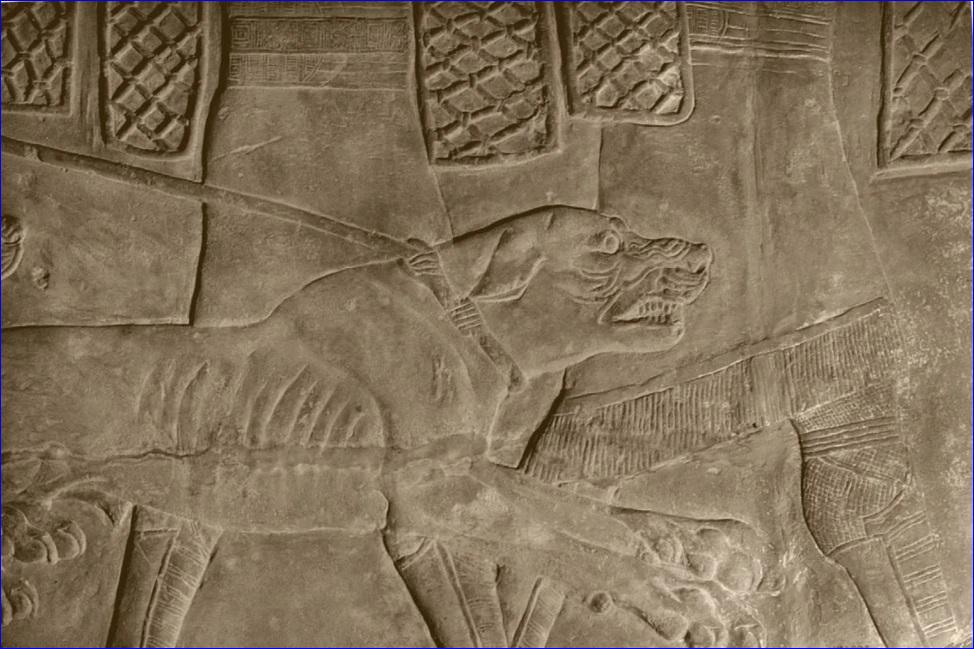


 Getty Images)
Getty Images)
But absent from this picture is an animal that played a significant role in ancient Mesopotamian culture, religion and warfare: the humble dog.
References to our canine companions are found again and again, recurring as motifs among clay tablets, temple reliefs and the archaeological record.
In Mesopotamian societies and cultures, dogs occupied positions across the spiritual, medical and military fields. They were trained for war, worshipped, and, in some cases, buried with great ceremony.
"There's lots of evidence from all kinds of [sources] about dogs in ancient Mesopotamia," explains historian Dr Moudhy Al-Rashid, speaking on the HistoryExtra podcast. "They definitely had dogs who were their faithful companions as they are to us today. They must have been a part of the fabric of everyday life."
Dogs on the front lines of ancient Mesopotamian war
Among the most striking roles dogs played was as warriors on the battlefield, says Al-Rashid.
"[Dogs] even went to war in some eras," Al-Rashid notes. "There are records of provisions for dogs of war," she says, referencing the inclusion of military dogs in supply lists, suggesting that they were accounted for in formal war logistics, found in cuneiform records.
Mesopotamian warfare was waged between rival city-states such as Ur, Lagash and Umma during earlier periods, and later between expansive competing empires such as the Akkadians, Assyrians and Babylonians. Campaigns involved sieges, raids and open battle with armies travelling long distances, and dogs were used in all of them.
Armies often relied on extensive logistical planning, with supply chains stretching across desert terrain. Rations, transport animals and camp protection were carefully organised, and dogs may have served as both early warning systems and companions to troops. Assyrian royal inscriptions, for example, detail military conquests in language closely tied to divine will -- and they suggest that dogs, like the king's soldiers, could have carried symbolic weight as enforcers of divine order.
Divine companions and temple guardians
The importance of dogs to the Mesopotamian civilisations certainly wasn't limited to the battlefield. They held significant religious symbolism in Mesopotamian belief systems, particularly in association with medicine.
"There's a goddess of healing, Gula, whose attributed animal is a dog," says Al-Rashid. "At her feet in most of her iconography is a dog just lying there looking like he's at attention."
Gula was invoked in ritual and medical texts, and temples dedicated to her served not only as religious spaces but in some cases as centres of healing practice.
There is even one, Al-Rashid notes, where there are, "just over 30 burials of dogs of all kinds of ages under the ramp leading up to this temple."
"They must have had some sort of important role in healing or in ritual related to healing," Al-Rashid says, though that precise role is still ambiguous.
Gula's association with dogs may have been grounded in their behaviour. Ancient Mesopotamians noticed that dogs licked their wounds, which seemed to promote healing, possibly creating the basis of the connection.
Ancient Mesopotamia's proverbs about dogs
The significance of these animals in ancient Mesopotamian culture is also apparent within the region's rich textual tradition, which includes a number of proverbs that reference dogs.
"There are some really lovely proverbs about dogs that are so relatable," says Al-Rashid. "There's one that describes a dog knowing how to pick something up but not put it down; I think anyone with a dog is familiar with that challenge."
There's another, Al-Rashid notes, "about how an older dog that gets played with turns into a puppy".
But not all references were light-hearted. One describes: "fate being like a dog always at your heels", which Al-Rashid says is much more "sinister".
Many of these proverbs were preserved on clay tablets used in scribal schools, where students learned not only writing, but also ethics and social understanding. Dogs, with their observable behaviour and emotional familiarity, evidently became ideal metaphors (for everything from simple joy to inescapable destiny) in a culture that valued metaphorical instruction.
In this way, dogs entered the culture's moral and philosophical vocabulary as symbols used to convey guidance, warn of life's uncertainties and capture essential truths about human nature.

or register to post a comment.